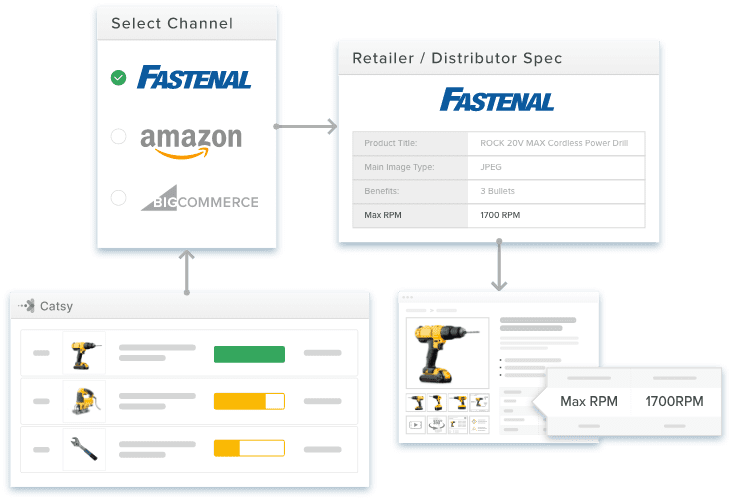Chaos to Clarity: How PIM Software Simplifies Product Catalog Management for Manufacturers

- Catalog management for manufacturers offers direct customer outreach, cost-effectiveness, and increased brand visibility.
- Successful catalog management relies on sound data management strategies supported by robust PIM software backend.
- PIM software streamlines catalog management, ensuring accuracy and consistency and maximizing the catalog's potential.
In this Article
As a manufacturer, you want your products to be the best in the market. You tune your production procedures and processes to create products that buyers will love. Unfortunately, quality is not always the final determinant of how much of the product you’ll sell.
Besides manufacturing, you must find a way to get customers to see and purchase the products. For a long time, brands have used catalogs to showcase their offerings. The catalogs were designed to persuade readers to find and buy the products.
Product catalogs bring in new customers and keep the existing ones. However, their effectiveness is dulled when the management strategy is built on legacy systems. Catalog management for manufacturers founded on legacy systems depends on highly manual processes and a slow turn-around when updating catalogs. Those who lose the battle against the chaos that arises from these limitations suffer irreparable damage to the brand.
Thankfully, manufacturers can streamline product catalog management using product information management (PIM) tools. Some PIM software vendors have designed their solutions to simplify catalog management, but you won’t find this information easily unless you stumble upon a post like this. Let’s find out more in the following paragraphs.

Understanding Product Catalogs and Catalog Management for Manufacturers
What is a product catalog?
A product catalog is an organized collection of details about your products. To illustrate the meaning of a product catalog, consider automotive sales. Automakers build showrooms to showcase vehicles. Potential buyers can walk in and inspect the cars from all angles and acquaint themselves with crucial details like horsepower, engine capacity, body type, etc.
Likewise, a product catalog is a showroom (digital for digital catalogs and physical for printed catalogs) for a manufacturer’s products. They allow brands to display product imagery, their attributes, technical specifications, and associated information.
So, if you are an industrial equipment manufacturer, the catalogs include various categories, such as power tools, safety equipment, and machinery. Each category would contain a list of products with detailed descriptions, technical specifications, high-quality images, and pricing information.
Components of product catalogs
We’ve already seen examples of information you can incorporate in product catalogs. More crucially, one must know that a detailed and sufficiently comprehensive catalog carries loads of information. The breadth of the details required for manufacturers is even wider.
Suppose you are a power tools manufacturer and want to create a product catalog. However, you think too many details need to be captured, and, as a result, you are lost on where to start. In that case, you can simplify the process by breaking the details down into five core components, including:
1. Core product information
Product name and description: A clear and concise name that identifies the tool (e.g., “18V Lithium-Ion Cordless Drill”), followed by a detailed description highlighting its key features and benefits.
Technical specifications: The nitty-gritty details that matter most to professionals. This might include:
- Motor power (watts)
- No-load speed (RPMs)
- Maximum drilling capacity (metal, wood, concrete)
- Chuck size
- Battery voltage and capacity (Ah)
2. Visuals and multimedia
High-quality images: Professional product photos showcasing the power tool from various angles, ideally in use-case scenarios. Include close-up shots of critical features.
Technical drawings: For complex tools, exploded diagrams or technical drawings can be invaluable for understanding parts, assemblies, and maintenance procedures.
Optional: Videos: Short explainer videos demonstrating the tool’s functionality and essential features can be a powerful addition, especially for digital catalogs.
3. Functionality and performance
Features and benefits: Clearly outline the tool’s functionalities and how they translate to user benefits. For example, highlight features like variable speed control for precise drilling or an ergonomic design for increased user comfort.
Performance data: Include relevant performance metrics when applicable. These could be maximum torque ratings, noise levels (decibels), or vibration levels.
4. Compliance and safety
Safety information: Clearly outline safety instructions and warnings for proper tool usage. This could be pictograms, written instructions, or links to downloadable safety manuals.
Compliance certifications: Indicate any relevant industry certifications or safety standards the tool meets (e.g., UL, CSA).
5. Marketing materials (Optional):
Brand messaging: While a core catalog focuses on technical details, you can consider incorporating brand messaging and value propositions. This could be short blurbs highlighting the brand’s commitment to quality or innovation.
Accessories and replacement parts: Include information on compatible accessories and replacement parts to encourage additional sales.
Note: The specific components and level of detail in a product catalog vary depending on the complexity of the product and the target audience. However, these core elements make the catalog a valuable resource for buyers seeking the right tool for the job.

Print vs. digital catalogs
The first catalog in recorded history was printed in Venice in 1498. On the contrary, it wasn’t until the early 1990s that the first digital catalogs appeared. This tells you that printed catalogs had centuries to entrench themselves into society, which explains why this catalog type has been a popular choice for manufacturers to showcase their products.
Understandably, digital catalogs have overtaken print for the obvious reason that more people consume online content. But that is not all. Buyers love digital catalogs for several reasons:
- Immediacy and convenience: They can access digital catalogs anywhere and anytime.
- Interactivity: Buyers can view videos that provide context and how to use products to refine purchase decisions. Some brands include interactive 3D models, hyperlinks, and direct “add-to-cart” functionality. This adds to the convenience buyers crave.
For businesses, digital catalogs are easy to update – it doesn’t require reprinting and re-circulating the copies to customers. This also implies a cost-effectiveness factor. Removing printing and distribution costs makes them a more affordable and scalable solution.
And yet, print catalogs are still popular, and customers love them. One analysis shows that businesses are actively printing and mailing catalogs. For marketers, print catalogs generate high engagement rates that often lead to contact with customers – 77% of customers contact businesses after receiving their catalogs in the mailbox.
Shockingly, a USPS study found that most customers (84%) enjoyed receiving printed catalogs from businesses they had shopped with before. No wonder direct-mailed catalogs have an excellent engagement score (95%). What is not shocking is the reasons print catalogs continue to stick around in the face of a dominant digital landscape. Some of the reasons include:
- Tactile experience: Customers can physically interact with the catalog, flipping through pages and marking their preferred products.
- Prestige and branding: High-quality printed catalogs convey a sense of professionalism and established expertise for manufacturers. Customers read this as signifying reliability.
- Offline accessibility: Print catalogs are indispensable in situations with limited internet connectivity, like trade shows or remote job sites.
- Longevity: Print catalogs often have a longer shelf life, as they can be referenced multiple times and retained for future use.
While print catalogs retain niche value, the trend toward digital catalogs is undeniable. Their ease of access, cost-efficiency, and adaptability make them a powerful tool for the modern manufacturer.

The Chaos of e-Commerce Product Catalog Management Without Specialized Tools
Let’s not take anything away from catalogs because they do what manufacturers need them to – they allow them to showcase products to buyers. The digitalization of product catalogs is one of the primary reasons for growing usage across organizations. This is confirmed by recent reports indicating that the catalog management systems market is on an upward trajectory. For example, a Global Market Insights (GMI) analysis concluded that the global catalog management system market size will expand at 11% CAGR between 2024 and 2032, which will see a significant jump from the $1.6 billion valuation in 2023.
With such a positive outlook, from where does the aspect of chaos originate?
Product catalog management is straightforward when it involves a thin inventory. This means manufacturers with two or fewer products, without variations, may store core details in spreadsheets and generate catalogs manually—however, challenges set in when the business expands.
Here’s how expansion creates more challenging catalog management:
- Expanding product lines: Introducing new products means more SKUs, descriptions, technical specifications, compatibility information, and associated sales and marketing materials to manage.
- New sales channels: Reaching new markets through multiple e-commerce platforms, marketplaces, and distributor networks means tailoring the creation and management of product information to match the requirements and formats of each channel.
- Global markets: Entering international markets intensifies the challenge with diverse languages, compliance regulations, and currency considerations.
However, business expansion is not the only factor that introduces inefficiencies in product catalog management for manufacturers. Customer expectations also matter. Buyers expect accurate, consistent, readily available product information across all channels. This increases the pressure on manufacturers to re-strategize, mainly if they previously relied on archaic catalog creation tactics and technologies.
Challenges of catalog management without specialized tools
Unfortunately, inefficiencies in business never go unpunished. Manufacturers who rely on manual processes and dated methodologies (such as storing product information locally or in cloud storage) may never enjoy the benefits of product catalogs. Some reasons include:
- Data fragmentation: As product information is gathered from various sources, such as suppliers, engineers, and marketing teams, it can become scattered and disorganized if not centrally stored and managed. This fragmentation leads to inconsistencies and inaccuracies.
- Manual updates: Without an automated system, updating comprehensive product information requires manual intervention, which is time-consuming and prone to human error.
- Scalability issues: As product lines expand, managing catalogs using traditional methods, such as spreadsheets or print catalogs, becomes increasingly unsustainable. These methods lack the flexibility and scalability to handle growing product ranges and evolving market demands efficiently.
- Channel proliferation: Manufacturers distribute product data across multiple platforms, including distributor websites, online marketplaces, and digital catalog platforms. Managing product data across these channels without specialized tools can be challenging.
- Compliance challenges: Without a streamlined process for managing compliance information, manufacturers may struggle to maintain accurate and up-to-date product data, potentially leading to legal and reputational risks.
If not acted upon quickly, these challenges could snowball into massive chaos that may collapse the business. One of the best, if not the best, solutions to the chaos of improper catalog management for manufacturers is the adoption of PIM software.

PIM Software: The Most Efficient Digital & Print Catalog Management for Manufacturers
What is PIM software?
PIM software is a data management tool that ingests product details from several sources and stores them in a centralized hub. You can also create product data manually through an intuitive user interface.
PIM platform allows users to organize and categorize product information using product attributes and tags. It also provides an enrichment feature, enabling brands to add details and standardize formats for better quality. The platform automates repetitive tasks like data entry, updates, and distribution.
Since product information is centrally stored and managed, this tool creates a single source of truth for product details across the organization and external partners. This also means stakeholders can collaborate efficiently to deliver a successful product across the development lifecycle.
How does this tool address the challenges of catalog management?
1. Centralized data management
Manufacturers complicate catalog management when they rely on product information stored in disparate locations. For example, product descriptions can be stored in a spreadsheet on the product manager’s computer, and technical specifications can be stored on another spreadsheet on the engineering lead’s computer.
This fragmentation creates islands of information. The thick walls around each island create impregnable data silos. The natural consequences are inconsistencies and inefficiencies, making it difficult for manufacturers to maintain a single source of truth for product information.
A PIM tool brings all the details into a centralized repository. This consolidated storage platform connects all relevant information, giving stakeholders a broad view of product data.
Some vendors, like Catsy, take product data centralization a notch higher. This solution offers a unified platform whereby buyers get a PIM and digital asset management software (DAM) tool under one roof. That way, brands can centrally manage core product details alongside related files and documents. This unified PIM and DAM configuration creates what Catsy calls an e-commerce PIM. To define an e-commerce PIM, think of it as a specialized PIM software targeted at businesses that operate online shops. These companies must hit two birds with one stone: on the one hand, they must provide enriched and up-to-date product information, and on the other hand, they must share high-quality, rich media to attract as many eyeballs as possible. No single platform can pull off this feat without Catsy’s configuration.
2. Streamlined updates and revisions
It would be near impossible to carry out error-free updates and revisions on catalogs if the product information isn’t centralized. Imagine you just printed a catalog last month and sent it to customers. However, a last-minute change in the technical specifications necessitated an update.
Since you mail the catalog monthly, you must wait until the next round to reflect the changes. Although trivial, this change may be the genesis of many issues for your catalog marketing strategy.
First, you’ll have to track (manually) the channels you shared the catalog: print and digital. Secondly, especially for print catalogs, you’ll have to engage designers (and incur an ad-hoc expense) to capture the changes and then reprint. For digital catalogs, you’ll have to hunt down each channel to make the changes.
None of these challenges arise when using PIM software as the backend for generating catalogs. You just make the changes once in the centralized repository and syndicate them to channels. Some PIM solutions shine more in this area.
For example, Catsy’s PIM DAM solutions offers a digital catalog feature that taps into the data repository to create catalogs on the fly. Even better, brands can embed the feature into their websites so that any changes made and approved inside the PIM system are automatically reflected on the product pages.
Furthermore, Catsy PIM can autogenerate PDFs of product data. Think of this as a way to create print catalogs, which you can print and mail or share via a branded URL. The best part is that these catalogs (the ones shared via branded URLs) are interactive. Customers can interact with the products like they would on a live website.
See our Shopify PIM in action and take benefits of our PIM and DAM integration.
3. Simplified multichannel catalog management
One of the reasons digital catalogs are increasingly popular is the ability of manufacturers to distribute them as widely as possible. This feature is crucial in the era of omnichannel e-commerce. Omnichannel e-commerce refers to an online selling strategy where businesses create a seamless customer experience across several channels.
Omnichannel e-commerce is a hit for a reason: studies show that marketing campaigns that leverage this strategy report an order rate 494% higher than single-channel strategies. No wonder 87% of online merchants recognize the former as a critical foundation for e-commerce success.
Unfortunately, it is nearly impossible to create a seamless user experience across several channels when the backend for your product catalogs is spreadsheets.
PIM software is ideal for multichannel catalog management because of centralized data management. That is not all. Most robust solutions, like Catsy PIM and DAM systems, have APIs to connect to e-commerce platforms like Shopify and BigCommerce. The direct linkage allows super-fast and automated communication, meaning any changes in the PIM platform will be reflected in the e-commerce platform once approved. This happens simultaneously across all connected platforms, including distributors and marketplaces.

Best Practices for Getting the Most Out of PIM System for Catalog Management
1. Start with a clear product data governance strategy.
The path to clarity begins with a blueprint. A data governance strategy creates a blueprint that will successfully guide the process of consolidating and sharing product information.
For instance, adopting a PIM solution should be a critical element of the strategy. It should also define the rules and standards that the software will enforce. A sample blueprint can include a statement like: “We will use PIM software as the backend for product catalogs. This platform will consolidate product details from spreadsheets in several locations and ERP and CRM platforms.”
Choosing PIM software to facilitate the creation of product catalogs is an excellent decision for the reasons discussed previously. Additionally, the tool will be indispensable when it’s time to scale the business to cater to additional regions.
2. Choose the right PIM software for your business needs
The choice of PIM software is consequential. It will determine if you will enjoy the tool’s full potential. For instance, an e-commerce PIM like Catsy works best when your catalog marketing strategy is geared towards bolstering the performance of your online storefront.
Look for a PIM tool that offers ostensibly niche yet crucial features like a branded interactive platform. This feature allows you to create a visually appealing and user-friendly digital catalog experience for distributors, retailers, and target buyers.
Most importantly, your chosen option must align with your specific business needs. Consider factors such as the size of your catalog, the number of sales channels, and scalability requirements.
3. Ensure data quality from the source.
“Garbage in, garbage out” is the reality regarding data management. Prioritize clean and accurate data entry processes at the point of origin. Establish validation rules and checks within the PIM system to catch errors before they spread across channels. Investing time and resources in high-quality product data input will save countless hours of clean-up later.
4. Define roles and assign ownership for data management.
Clearly define who is responsible for creating, updating, and approving different types of product data (e.g., marketing team for product descriptions, technical team for specifications). This improves accountability and ensures that data remains accurate and consistent. It also creates a more streamlined workflow within the PIM system.
5. Provide ongoing training and support for users.
A product information system, while powerful, requires training for your team to achieve optimal results. Regular training sessions and support resources will ensure everyone understands how to use the system effectively, ultimately reducing errors and maximizing the value of your investment.
Conclusion
Catalog marketing is a vital strategy for manufacturers. It allows direct engagement with potential shoppers, delivers a cost-effective marketing approach, offers unmatched flexibility, and creates a trusted source of product information.
However, to fully harness the power of catalog marketing, manufacturers must establish a robust data management strategy with product information management software at its core. This tool centralizes product data, streamlining catalog updates, ensuring channel consistency, and simplifying multichannel management.
In other words, manufacturers multiply the odds of successful catalog management by an order of ten or more when they anchor the strategy on PIM software and DAM system. This offers a holistic approach to reaching, engaging, and converting customers.
It is the ability to centralize and streamline the management of all product data in a single source of truth. This ensures consistency, accuracy, and efficiency across various channels and touchpoints.
PIM solutions like Catsy support channel-specific formatting and localization requirements. They provide templates to allow businesses to adapt product information to meet the unique needs of each channel. Additionally, PIM software comes with APIs and bespoke connectors to several third-party systems and platforms. This feature allows businesses to syndicate data across multiple channels without human intervention effortlessly.
It validates and enriches product information at the source, maintaining accuracy and consistency. It also allows for bulk editing, version control, and approval workflows, ensuring that product data is up-to-date and error-free.
Nope. PIM software can be beneficial for manufacturers of all sizes. As your business grows and your product offerings expand, PIM helps you stay organized and efficient. Even smaller manufacturers can leverage PIM to streamline catalog management and ensure data accuracy across channels.
The first step is to assess your specific needs and identify the most critical functionalities for your business. Research different PIM software options and consider factors like scalability, budget, and integrations with your existing systems. Many PIM vendors offer demos, allowing you to test the software before committing.




